Hollywood Legends at LBI
Emigrant Artists, American Movies
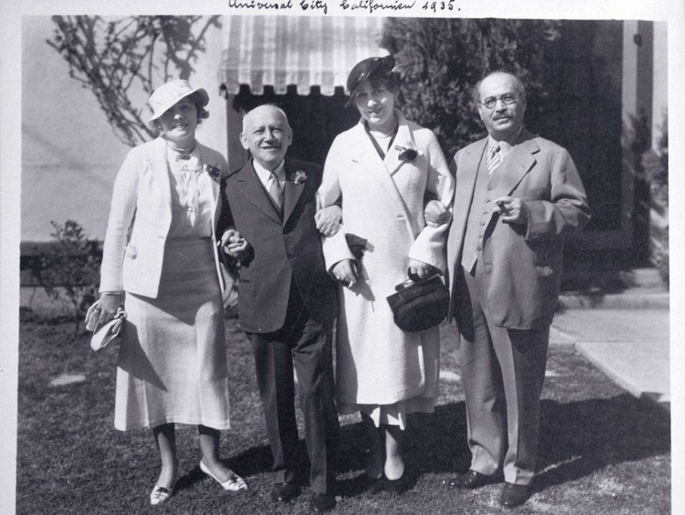
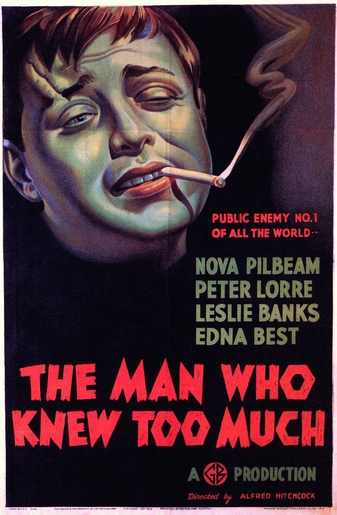
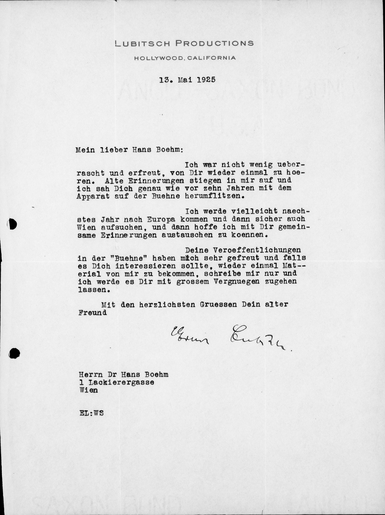


“The single most influential group in the development of the motion picture industry - the group most responsible for fashioning a cultural discourse through the film medium that helped shape American identity and a sense of America as wholly novel constructs of a cultural center accessible to all - were Jewish immigrants from Europe and their descendants.” - Leon Botstein, “Hollywood and the Birth of Audiovisual America,” from Bigger Than Life: 100 Years of Hollywood - A Jewish Experience
The collections of the Leo Baeck Institute contain a wealth of material on some of the most legendary figures from the Golden Age of Hollywood, which began in the late 1920s with the advent of sound and ended in the early 1960s with the decline of the studio system. The history of Hollywood cannot be told without highlighting the major role played by two waves of Jewish immigration to the United States: those who arrived in the late nineteenth and early twentieth centuries, a group that founded many of the most important movie studios and helped establish Hollywood as the center of the American film industry, and those who arrived in the 1930s after the rise of the Nazis, a group that included a multitude of talents both in front of and behind the camera.

Carl Laemmle: Born on Radstrasse in the Jewish Quarter of Laupheim, Germany in 1867, Carl Laemmle was the oldest and arguably most influential of the major studio founders. He arrived in the United States in 1884, bought his first nickelodeon in Chicago in 1906, and was running the largest film distribution company in the U.S. by 1910. Wanting to expand into film production, he fought the monopoly of Thomas Edison’s Motion Picture Patents Company and won, paving the way for the creation of Universal Pictures Corporation in 1912. In 1915, he opened Universal City, his sprawling Hollywood studio, effectively leading the motion picture industry’s move west.
Today, Laemmle is most famous for Universal's iconic horror films such as The Phantom of the Opera (1925) and Dracula (1931); he also won the 1930 Academy Award for Best Picture for All Quiet on the Western Front, a film that was banned in his native Germany after Nazis repeatedly disrupted screenings. Throughout his life, Laemmle remained devoted to his hometown of Laupheim and the surrounding area, providing financial support as well as personally sponsoring hundreds of Jewish emigrants fleeing Nazi Germany for the United States up until he died in 1939. In a 1937 letter to the Consul General in Stuttgart, Laemmle said, “When I issue an affidavit, you may be sure that I am doing it with the full knowledge of my responsibility and that my whole heart and soul is in it. I need not tell you of the suffering that the Jews of Germany are going through in these times and I, for one, feel that every single Jew who is in a financial position to help those badly in need should do so unswervingly.” You can learn more about Carl Laemmle at the Museum zur Geschichte von Christen und Juden in his hometown of Laupheim, where there is the permanent exhibition Carl Laemmle: Laupheim Native and Man of the World devoted to his fascinating life and career.
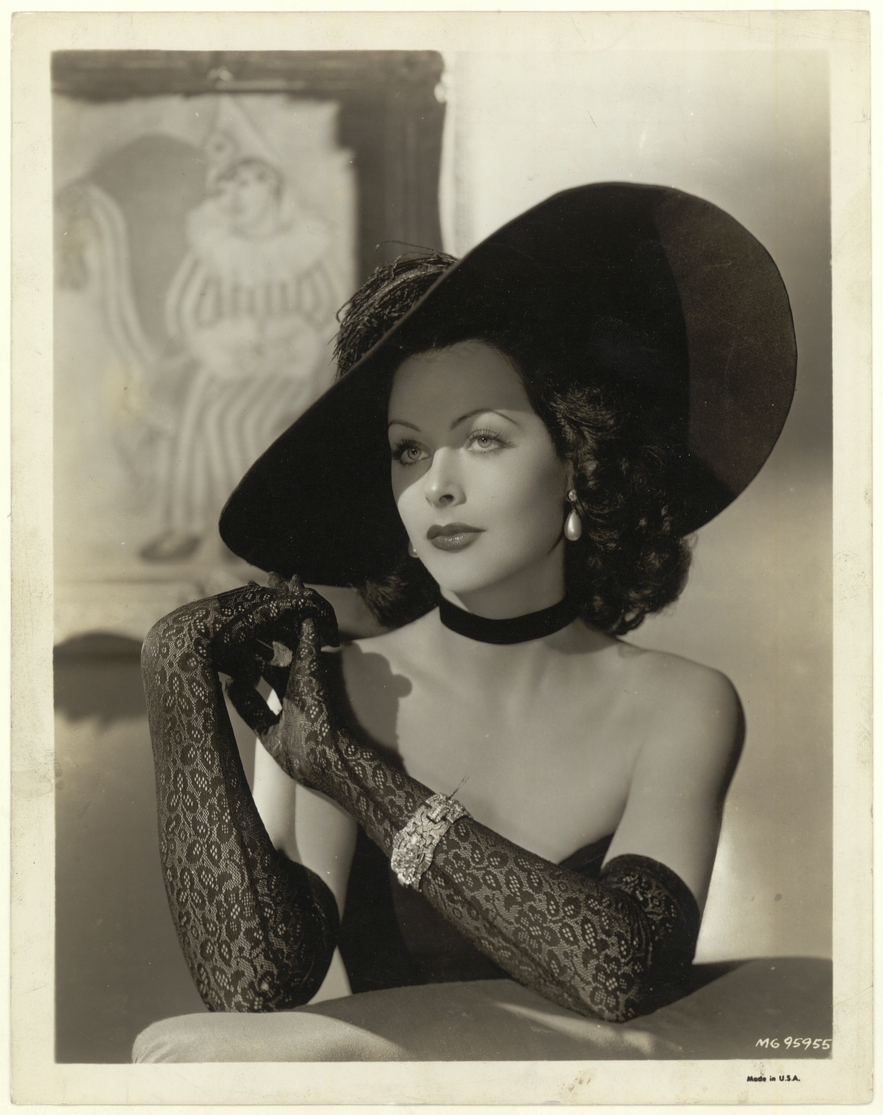
Hedy Lamarr: Born Hedwig Eva Maria Kiesler in Vienna in 1914, the girl who would become known as Hedy Lamarr caused a stir in Europe and abroad when she appeared nude in the 1933 Czechoslovak film Ecstasy. At the age of nineteen, she married arms mogul Fritz Mandl, converting from Judaism to Catholicism in the process, but Mandl’s controlling nature and attempts to thwart her burgeoning acting career resulted in her fleeing to the United States. Louis B. Mayer signed her to a contract with MGM and, at the suggestion of his wife, changed her name to Hedy Lamarr in honor of the deceased silent film actress Barbara La Marr. Lamarr’s unparalleled beauty made her a star but also prevented her from being taken seriously as an actress, with her being quoted as saying, “My beauty is my curse.”
In addition to appearing in such memorable films as Algiers (1938) and Comrade X (1940), Lamarr was a creative thinker and inventor who experimented with carbonated drink tablets that would dissolve in water and suggested airplane design modifications to Howard Hughes. However, her most impactful invention was a remote-control system with a frequency-hopping technique designed to help guide torpedoes that she created with composer George Antheil in 1942. While Lamarr received little credit for her invention at the time, it forms the basis for the Bluetooth and mobile communications technology we use today. Lamarr’s inventions were just one way she sought to combat the Nazis during World War II; she also entertained U.S. troops at the Hollywood Canteen and sold $25 million of war bonds.
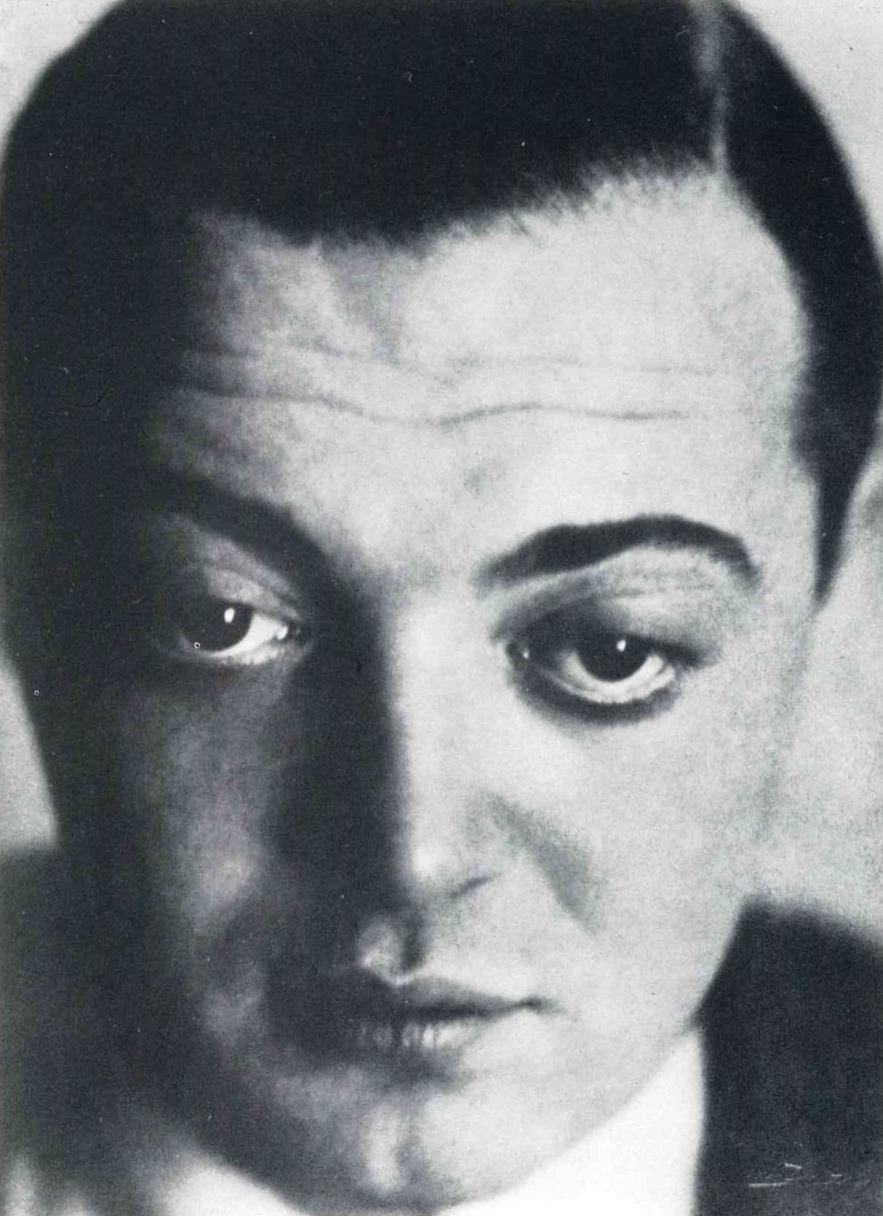
Peter Lorre: Born László Löwenstein in what is now Ružomberok, Slovakia in 1904, Peter Lorre abandoned his family’s plans for him to become a banker to pursue a career in the theater. After developing his craft in small experimental theatrical companies, he made his name on the Berlin stage as one of Bertolt Brecht’s go-to actors. His star rose further following his acclaimed performance as child-killer Hans Beckert in Fritz Lang’s film M (1931). Footage from M was later utilized in the antisemitic Nazi propaganda film The Eternal Jew (1940) in an attempt to argue that Jewish people were inherently “abnormal and depraved.”
Lorre fled Germany when the Nazis came to power in 1933, first landing in London, where he learned his lines phonetically for his first English-language role in Alfred Hitchcock’s The Man Who Knew Too Much (1934), before eventually making his way to Los Angeles. Despite Hollywood’s attempts to repeatedly cast him as creeps and criminals in the mold of Hans Beckert, he developed a solid career as a character actor, with his large eyes, small stature, and distinctive voice leaving their mark on classics such as The Maltese Falcon (1941) and Casablanca (1942). Following World War II, Lorre returned to West Germany and co-wrote, directed, and starred in the film The Lost One (1951), a thriller that wrestles with German guilt for Nazi war crimes. It was unsuccessful at the German box office, and Lorre returned to Hollywood, never to direct another movie.

Ernst Lubitsch: Born to a Jewish family in Berlin in 1892, Ernst Lubitsch rejected the opportunity to join his father’s tailoring business to become an actor. After a period of treading the boards as a member of Max Reinhardt’s ensemble, he transitioned to the screen. While he began as an actor, he quickly transitioned to directing everything from historical epics like Madame Du Barry (1919) to raucous comedies like The Oyster Princess (1919). Lubitsch’s work as a director earned him acclaim both at home and abroad, and soon Mary Pickford summoned him to the United States to direct her in Rosita (1922).
Lubitsch remained in Hollywood for the rest of his career, earning three Academy Award nominations for Best Director as well as an Honorary Academy Award in 1946. His best-known Hollywood films include The Shop Around the Corner (1940), which he consistently said was his favorite thing he ever directed, and To Be or Not to Be (1942), a satirical comedy set during the Nazi occupation of Poland. Lubitsch was also one of the founders of the European Film Fund, which was formed in 1938 to help those fleeing the Nazis obtain affidavits, money, and jobs in Hollywood. Writers such as Heinrich Mann were able to secure visas to enter the United States thanks to temporary writer’s contracts with major film studios that were secured by the European Film Fund.

Fritz Lang: Born in Vienna in 1890, Fritz Lang spent his youth traveling the world and studying art before volunteering to join the Austrian Army at the start of World War I. Wartime injuries deprived him of sight in one eye, but that didn’t stop him from going on to become one of Germany’s most acclaimed filmmakers. His groundbreaking work on films such as the fantastical epic Die Nibelungen (1924), the stylized sci-fi masterpiece Metropolis (1927), and the crime thriller M (1931) helped define the tropes of those respective genres while they were still in their infancy. His film The Testament of Dr. Mabuse (1933) featured villainous characters speaking similarly to the Nazis, leading Goebbels to ban the film. This didn't stop Goebbels from offering Lang the chance to take control of the Nazi film industry; however, Lang’s opposition to Nazi ideology and worries about his heritage – his mother was born Jewish but later converted to Catholicism – led him to emigrate, first to Paris and then to Hollywood.
Most of Lang’s Hollywood films didn’t receive the same acclaim as the films he made earlier in his career, but the lingering influence of German Expressionism can be seen in the shadowy, nightmarish visuals of films like Fury (1936) and Scarlet Street (1945). One of the founders of the Hollywood Anti-Nazi League, Lang also made several explicitly anti-Nazi films in Hollywood, including Man Hunt (1941), which was designed to increase American sympathy with the British and change minds about entering the war, and Hangman Also Die! (1943), which loosely depicted the assassination of Heydrich from a story by Bertolt Brecht. In the late 1950s, Lang returned to Germany to direct his final three films; however, the most memorable film from his late career is one in which he appears on screen: Jean-Luc Godard’s Contempt (1963), in which Lang plays himself.
Salka Viertel: Born Salomea Sara Steuermann in Galicia in 1889, Salka was working as a stage actress in Vienna when she met writer and director Berthold Viertel. They married in 1918, and in 1928, when Berthold was offered a contract with Fox Film Corporation as a writer and director, they moved to Hollywood with their three young sons. There, Salka attempted to continue her acting career, notably co-starring with Greta Garbo in the German version of Garbo’s first talkie, Anna Christie (1930). While more quality roles did not materialize, Salka became a close friend and confidant of the notoriously shy and mercurial Garbo. Deciding to focus on screenwriting, Salka co-wrote scripts for five films starring Garbo, most famously the historical drama Queen Christina (1933), among several others.
Perhaps more important than her contributions to Hollywood films were her contributions to the Hollywood émigré community. One of the co-founders of the European Film Fund, Salka helped numerous artists and intellectuals fleeing the Nazis make their way to the United States. Once these refugees arrived in Hollywood, they could look forward to weekly salons at the Viertels’ home in Santa Monica. Here, Salka would connect newly arrived artists with those already established in Hollywood and do her best to make them feel at home; everyone from Thomas Mann to Charlie Chaplin could be found there on Sunday afternoons enjoying Salka’s famous chocolate cake. In the years following the war, she was suspected of being a Communist and effectively blacklisted in Hollywood. Instead, she focused on writing her memoir, The Kindness of Strangers (1969), which provides a vivid portrait of the Hollywood studio system and the community of exiles that she helped to nurture.

Billy Wilder: Born Samuel Wilder to a Polish Jewish family in Galicia in 1906, Billy Wilder was given the nickname by which he’d become famous by his mother, who had fond memories of seeing Buffalo Bill’s Wild West Shows on an earlier trip to the U.S. While working as a journalist in Vienna, Wilder interviewed American bandleader Paul Whiteman, who brought him along to Berlin and introduced him to others in the entertainment industry. Soon Wilder was working as a producer and screenwriter on such notable films as People on Sunday (1930), a landmark of the naturalistic New Objectivity movement that emerged in response to the heavy stylization of German Expressionism. With the rise of the Nazis, Wilder escaped first to Paris, then to Hollywood; tragically, his mother, stepfather, and grandmother remained in Europe and were murdered during the Holocaust.
In Hollywood, Wilder began working as a screenwriter, notably co-writing with Walter Reisch and Charles Brackett the script for Ernst Lubitsch’s comedy Ninotchka (1939), starring Greta Garbo. (Lubitsch’s influence on Wilder was so strong that Wilder had a sign hanging on the wall in his office reading “How Would Lubitsch Do It?”) In the 1940s and 1950s, he wrote, directed, and produced a string of acclaimed films that are today regarded as some of the greatest ever made, including Double Indemnity (1944), Sunset Boulevard (1950), Some Like It Hot (1959), and The Apartment (1960). Over the course of his career, he was nominated for 21 Academy Awards and won six.

Vicki Baum: Born to a Jewish family in Vienna in 1888, Hedwig “Vicki” Baum’s first forays into the arts were as a harpist training at the Vienna Conservatory. After several years working as a journalist in Berlin, she published her first novel at the age of 31. While she wrote over 50 books throughout her career, the one for which she is most famous is Menschen im Hotel (1929). The novel was a huge international success, and Baum was summoned to Hollywood, where Edmund Goulding was directing a screen adaptation titled Grand Hotel (1932). A star-studded MGM ensemble piece featuring the likes of Joan Crawford, Greta Garbo, John Barrymore, and Lionel Barrymore, Grand Hotel went on to win Best Picture at the 1932 Academy Awards.
Baum returned to Berlin when production on Grand Hotel wrapped, but the city was not the same one she had left: “I looked at the faces of the demonstrating mobs on the streets; the haggard sharp-jawed faces and sagging old trench coats of the disenchanted veterans and the unemployed; I saw hatred and fanaticism everywhere in this world…and I thought: I have two nice boys; what will Germany make of them?” Not willing to stick around and find out, Baum emigrated to the United States with her husband and two sons, where she parlayed the success of Grand Hotel into a career as a writer in Hollywood; among the films for which she received story credit are The Night is Young (1935) and Dance, Girl, Dance (1942).
Learn more at LBI:
Baum, Vicki. Es war alles ganz anders; Erinnerungen. Ullstein, 1962. (LBI Library, PT 2603 A815 A25)
Bayer, Udo. Carl Laemmle 17.01.1867-24.09.1939: Laemmle's List Affidavits Save Lives. Carl Laemmle Press, 2016. (LBI Library, st 16443)
Bayer, Udo. Carl Laemmle: Von Laupheim nach Hollywood. Hentrich & Hentrich, 2015. (LBI Library, q 1026)
Blaumer, Nikolai, et. al. Thomas Mann’s Los Angeles: Stories from Exile 1940-1952. Angel City Press, 2022. (LBI Library, st 14881)
Chandler, Charlotte. Nobody’s Perfect: Billy Wilder, a Personal Biography. Simon & Schuster, 2002. (LBI Library, st 1928)
Hanak-Lettner, Werner, et. al. Bigger Than Life: 100 Years of Hollywood - A Jewish Experience. Bertz + Fischer, 2011. (LBI Library, q 858)
Hanisch, Michael. Billy Wilder (1906-2002): von Galizien nach Beverly Hills. Hentrich & Hentrich, Stiftung Neue Synagoge, Centrum Judaicum, 2004. (LBI Library, st 3316)
Hanisch, Michael. Ernst Lubitsch (1892-1947): Von der Berliner Schönhauser Allee nach Hollywood. Hentrich & Hentrich, Centrum Judiacum, 2003. (LBI Library, sm 4 v. 5)
Horowitz, Joseph. Artists in Exile: How Refugees from Twentieth-Century War and Revolution Transformed the American Performing Arts. Harper, 2008. (LBI Library, st 5546)
Hubert, Ali. Hollywood: Legende und Wirklichkeit. Verlag E.A. Seemann, 1930. (LBI Library, st 15961)
McGilligan, Patrick. Fritz Lang: The Nature of the Beast. St. Martin's Press, 1997. (LBI Library, PN 2658 L3 M34 1997)
Nottelmann, Nicole. Ich liebe Dich. Für immer: Greta Garbo und Salka Viertel. Aufbau, 2011. (LBI Library, st 15757)
Nottelmann, Nicole. Die Karrieren der Vicki Baum: Eine Biographie. Kiepenheuer & Witsch, 2007. (LBI Library, st 8394)
Omasta, Michael, et. al. Peter Lorre: Schauspieler in Wien, Berlin, und Hollywood. SYNEMA - Gesellschaft für Film und Medien, 2014. (LBI Library, st 9850)
Paul, William. Ernst Lubitsch’s American Comedy. Columbia University Press, 1983. (LBI Library, PN 2658 L8 P3)
Poague, Leland A., and Hooper, Gary. The Cinema of Ernst Lubitsch. A. S. Barnes, 1978. (LBI Library, PN 2658 L8 P63 1978)
Porges, Friedrich. Mein Film-Buch; vom Film, vom Tonfilm, von Filmstars und von Kinematographie. "Mein Film" Verlag, 1930. (LBI Library, PN 1993.3 M4 1930)
Schnauber, Cornelius. Fritz Lang in Hollywood. Europaverlag, 1986. (LBI Library, PN 2658 L3 S3)
Sharp, Anne. Walking the Shark: A Peter Lorre Book. Xlibris, 2003. (LBI Library, f 268)
Stanca-Mustea, Cristina. Carl Laemmle: der Mann, der Hollywood erfand: Biografie. Osburg, 2013. (LBI Library, st 17878)
Viertel, Salka. The Kindness of Strangers: A Theatrical Life. Holt, Rinehart and Winston, 1969. (LBI Library, st 4229)
Winklbauer, Andrea, et. al. Lady Bluetooth: Hedy Lamarr. Jüdisches Museum Wien, 2019. (LBI Library, f 1321)